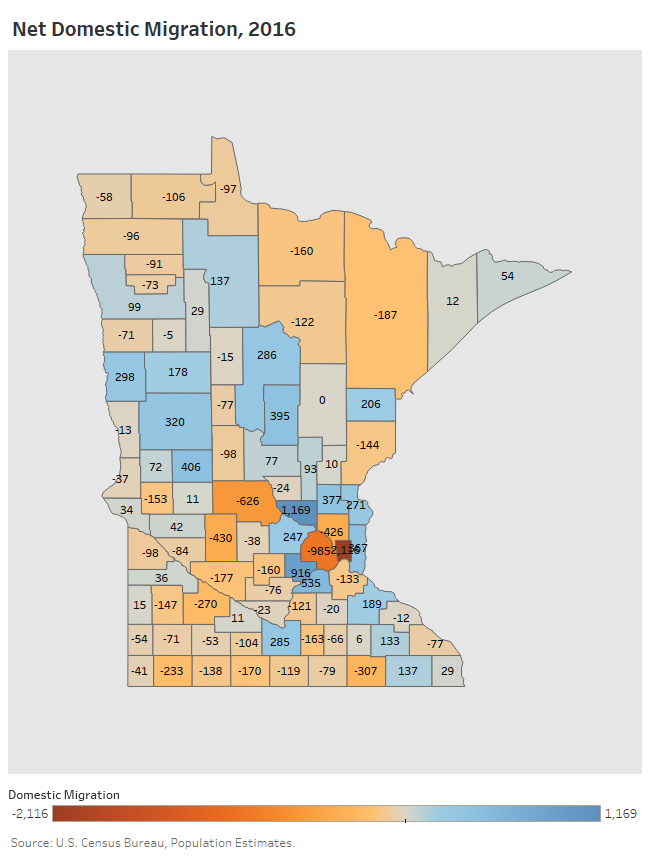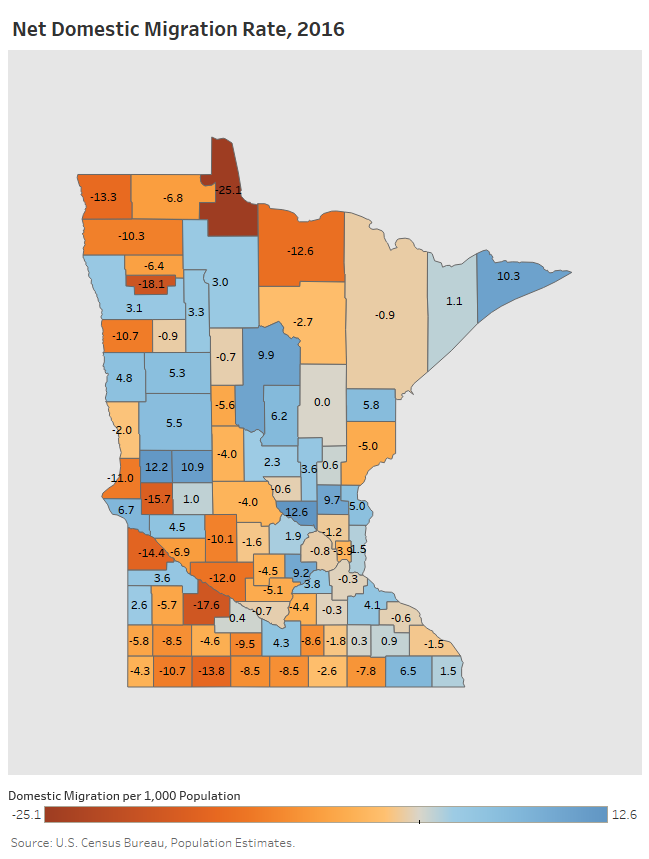MN Loses Population to Other States in 2016 But Some Counties Buck Trend
Migration, especially domestic migration, is a key indicator of the desirability and success of an area. People vote with their feet and move to places with good jobs, affordable housing, and strong communities. County-level statistics on population change released by the U.S. Census Bureau last week reveal which areas of Minnesota are winning and losing this vote.
Minnesota has been losing population due to people moving away to other states since 2002 and that trend continued in 2016. Among Minnesota’s counties, 51 lost population from net domestic migration, 35 gained population, and Aitkin County netted out at zero.
The five counties experiencing the largest losses include Ramsey County (St. Paul), Hennepin County (Minneapolis), Stearns County (St. Cloud), Kandiyohi County (Willmar), and Anoka County.
The five counties experiencing the largest gains include Sherburne County, Carver County, Scott County, Douglas County (Alexandria), and Crow Wing County (Brainerd).
Not surprisingly, most of the top losers and gainers are high population counties located in the Twin Cities.
What might be a surprise is that the counties home to Alexandria and Brainerd are among the top gainers. Fergus Falls, Moorhead and Mankato also posted gains. These communities are bucking the trend of declining population in greater Minnesota.

Center of the American Experiment held town meetings in Fergus Falls and Alexandria to learn what makes those communities a success. Just 50 miles apart along Interstate 94 in west central Minnesota, the two communities adopted a similar strategy to better prepare students for the workforce needs of local businesses.
Years ago, these communities saw the need to show students and parents the great career opportunities available at local manufacturers. The school district, community college and manufacturers then partnered to meet this need. From that partnership, local businesses helped fund and install state-of-the-art manufacturing labs in the Alexandria and Fergus Falls high schools. And in Fergus Falls, all ninth-grade students must take Introduction to Tech ED. No doubt these educational efforts are part of why both Fergus Falls and Alexandria school districts experienced significant increases in enrollment this year.
The Center’s research on Minnesota’s economy suggests these communities also benefit from low taxes on manufacturers. Yes, low taxes. While Minnesota tends to be a very high tax state for most businesses, manufacturers get a big break because sales of products shipped to other states are not taxed. Due largely to that tax provision, Minnesota imposes the second lowest tax rate on capital intensive manufacturers and the 17th lowest rate on labor-intensive manufacturers, according to the Tax Foundation.
Growth in the Minnesota’s manufacturing sector is the main reason the state’s economy manages to keep pace with the nation. As the Center’s 2016 report on Minnesota’s economy revealed, “The growth advantage in Minnesota’s manufacturing industry—the difference between Minnesota’s actual growth and what growth would have been if Minnesota’s manufacturing sector grew at the national average—added another $7.1 billion to Minnesota’s economy between 2000 and 2015.” The next best sector added just $1.8 billion.
It’s no coincidence that Minnesota manufacturers experience stronger GDP growth than higher taxed industries in the state.
Though some Minnesota communities might be, on net, attractive places to move, Minnesota can do much better. Sherburne County—Minnesota’s fastest growing county—grew at a rate that was still slower than 294 counties across the country.
Much like Sherburne County is catching the expansion of the Twin Cities, Dallas County, Iowa is catching the western expansion of Des Moines. However, Dallas County grew at the rate of 30.2 per 1,000 people in 2016, far higher than Sherburne’s rate of 12.6 per 1,000. The entire Des Moines metro area attracted a net of 5,908 people from other states. By comparison, the Twin Cities metro area added only 405 people from net domestic migration.
Des Moines shows that being in the Midwest does not destine a city for mediocre growth. Minnesota can indeed do better. As the state’s strong manufacturing sector shows, lower taxes can help.
